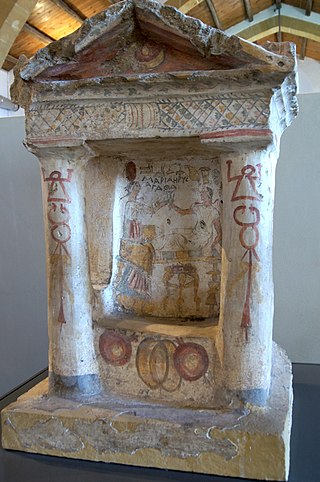
In ancient Roman religion, an aedicula is a small shrine, and in classical architecture refers to a niche covered by a pediment or entablature supported by a pair of columns and typically framing a statue, the early Christian ones sometimes contained funeral urns. Aediculae are also represented in art as a form of ornamentation.

An altar is a table or platform for the presentation of religious offerings, for sacrifices, or for other ritualistic purposes. Altars are found at shrines, temples, churches, and other places of worship. They are used particularly in paganism, Christianity, Buddhism, Hinduism, Judaism, modern paganism, and in certain Islamic communities around Caucasia and Asia Minor. Many historical-medieval faiths also made use of them, including the Roman, Greek, and Norse religions.

An altarpiece is an work of art in painting, sculpture or relief representing a religious subject made for placing at the back of or behind the altar of a Christian church. Though most commonly used for a single work of art such as a painting or sculpture, or a set of them, the word can also be used of the whole ensemble behind an altar, otherwise known as a reredos, including what is often an elaborate frame for the central image or images. Altarpieces were one of the most important products of Christian art especially from the late Middle Ages to the era of Baroque painting.

A reredos is a large altarpiece, a screen, or decoration placed behind the altar in a church. It often includes religious images.
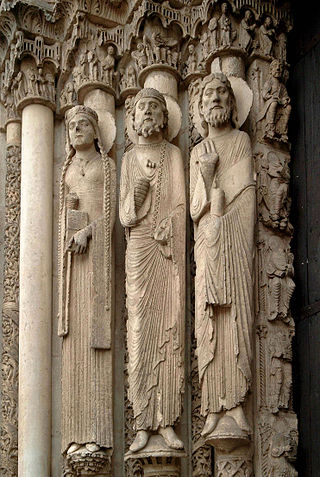
Gothic art was a style of medieval art that developed in Northern France out of Romanesque art in the 12th century AD, led by the concurrent development of Gothic architecture. It spread to all of Western Europe, and much of Northern, Southern and Central Europe, never quite effacing more classical styles in Italy. In the late 14th century, the sophisticated court style of International Gothic developed, which continued to evolve until the late 15th century. In many areas, especially Germany, Late Gothic art continued well into the 16th century, before being subsumed into Renaissance art. Primary media in the Gothic period included sculpture, panel painting, stained glass, fresco and illuminated manuscripts. The easily recognizable shifts in architecture from Romanesque to Gothic, and Gothic to Renaissance styles, are typically used to define the periods in art in all media, although in many ways figurative art developed at a different pace.
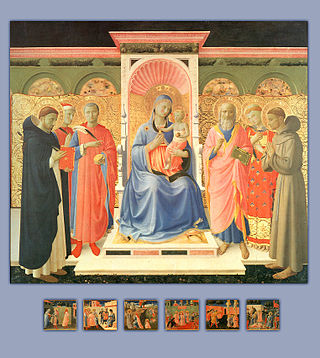
In art, a sacra conversazione, meaning "holy conversation", is a genre developed in Italian Renaissance painting, with a depiction of the Virgin and Child amidst a group of saints in a relatively informal grouping, as opposed to the more rigid and hierarchical compositions of earlier periods. Donor portraits may also be included, generally kneeling, often their patron saint is presenting them to the Virgin, and angels are frequently in attendance.

A panel painting is a painting made on a flat panel of wood, either a single piece or a number of pieces joined together. Until canvas became the more popular support medium in the 16th century, panel painting was the normal method, when not painting directly onto a wall (fresco) or on vellum. Wood panels were also used for mounting vellum paintings.
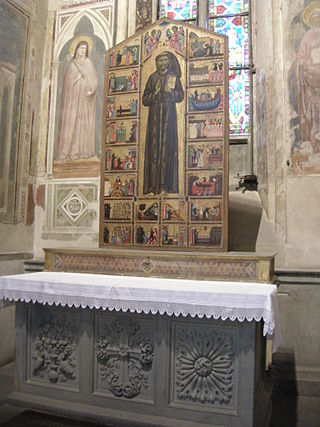
A Dossal, from French dos (back), is one of a number of terms for something rising from the back of a church altar. In modern usage, it primarily refers to cloth hangings but it can also denote a board, often carved or containing a painting, that rises vertically from the back of the altar and to which the cloth is attached. Retable and reredos are alternative terms for solid structures, as is altarpiece, all of them rather more commonly used today.

A retablo is a devotional painting, especially a small popular or folk art one using iconography derived from traditional Catholic church art. More generally retablo is also the Spanish term for a retable or reredos above an altar, whether a large altarpiece painting or an elaborate wooden structure with sculptures. Typically this includes painting, sculpture, or a combination of the two, and an elaborate framework enclosing it. The Latin etymology of the Spanish word means "board behind". Aside from being found behind the altar, "similar ornamental structures are built and carved over facades and doorways", called overdoors.

The Assumption of the Virgin or Frari Assumption, popularly known as the Assunta, is a large altarpiece panel painting in oils by the Italian Renaissance artist Titian, painted in 1515–1518. It remains in the position it was designed for, on the high altar of the Basilica di Santa Maria Gloriosa dei Frari or Frari church in Venice. It is the largest altarpiece in the city, with the figures well over life-size, necessitated by the large church, with a considerable distance between the altar and the congregation. The images above and below are not Titian's work, they are by Palma Vecchio. It marked a new direction in Titian's style, that reflected his awareness of the developments in High Renaissance painting further south, in Florence and Rome, by artists including Raphael and Michelangelo. The agitated figures of the Apostles marked a break with the usual meditative stillness of saints in Venetian painting, in the tradition of Giovanni Bellini and others.

The altar in the Catholic Church is used for celebrating the Sacrifice of the Mass.

Gilded woodcarving in Portugal is, along with azulejos, one of the country's most original and rich artistic expressions. It is usually used in the interior decoration of churches and cathedrals and of noble halls in palaces and large public buildings. An impressive collection of altarpieces are found in Portuguese churches. Originating in the Gothic era, Portuguese gilded woodcarving assumed a nationalist character during the 17th century and reached its height in the reign of King D. João V. In the 19th century it lost its originality and began to disappear with the end of the revival era.

Jacques de Baerze was a Flemish sculptor in wood, two of whose major carved altarpieces survive in Dijon, now in France, then the capital of the Duchy of Burgundy.

In ecclesiastical architecture, a ciborium is a canopy or covering supported by columns, freestanding in the sanctuary, that stands over and covers the altar in a basilica or other church. It may also be known by the more general term of baldachin, though ciborium is often considered more correct for examples in churches. Really a baldachin should have a textile covering, or at least, as at Saint Peter's in Rome, imitate one. There are exceptions; Bernini's structure in Saint Peter's, Rome is always called the baldachin.
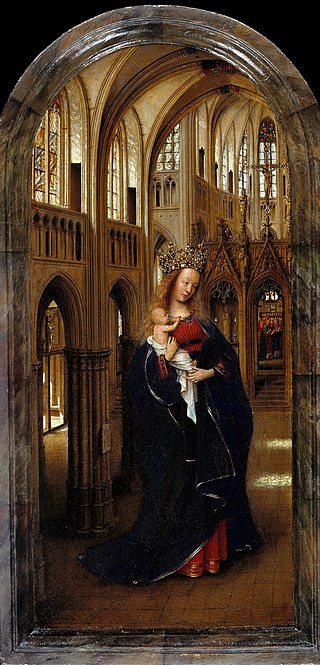
Madonna in the Church is a small oil panel by the early Netherlandish painter Jan van Eyck. Probably executed between c. 1438–1440, it depicts the Virgin Mary holding the Child Jesus in a Gothic cathedral. Mary is presented as Queen of Heaven wearing a jewel-studded crown, cradling a playful child Christ who gazes at her and grips the neckline of her red dress in a manner that recalls the 13th-century Byzantine tradition of the Eleusa icon. Tracery in the arch at the rear of the nave contains wooden carvings depicting episodes from Mary's life, while a faux bois sculpture in a niche shows her holding the child in a similar pose. Erwin Panofsky sees the painting composed as if the main figures in the panel are intended to be the sculptures come to life. In a doorway to the right, two angels sing psalms from a hymn book. Like other Byzantine depictions of the Madonna, van Eyck depicts a monumental Mary, unrealistically large compared to her surroundings. The panel contains closely observed beams of light flooding through the cathedral's windows. It illuminates the interior before culminating in two pools on the floor. The light has symbolic significance, alluding simultaneously to Mary's virginal purity and God's ethereal presence.

A winged altarpiece or winged retable is a special form of altarpiece, common in Northern and Central Europe, in which the central image, either a painting or relief sculpture can be hidden by hinged wings. It is called a triptych if there are two wings, a pentaptych if there are four, or a polyptych if there are four or more. The technical terms are derived from Ancient Greek: τρίς: trís or "triple"; πέντε: pénte or "five"; πολύς: polýs or "many"; and πτυχή: ptychē or "fold, layer".

Lutheran art consists of all religious art produced for Lutherans and the Lutheran churches. This includes sculpture, painting, and architecture. Artwork in the Lutheran churches arose as a distinct marker of the faith during the Reformation era and attempted to illustrate, supplement and portray in tangible form the teachings of Lutheran theology.

Adriaen van Overbeke, Adrian van Overbeck and Adriaen van Overbeke was a Flemish Renaissance painter in the style of Antwerp Mannerism. He operated a large workshop with an important output of altarpieces, which were mainly exported to Northern France, the Rhineland and Westphalia. His known works were predominantly polychromed wooden altarpieces with painted shutters, which were created through a collaboration between painters and sculptors.

The Despenser Reredos or Despenser Retable is a medieval altarpiece now in St Luke's Chapel, Norwich Cathedral. It is the cathedral's most important work of art. The altarpiece shows five scenes from the end of Christ's life—his flagellation, his journey to the cross, his crucifixion, events that follow his burial, and the Ascension. The scenes, which are painted on wood in vivid colours, are surrounded by a rectangular frame. The original reredos may originally have been positioned at the cathedral's high altar.

Puchner's Ark is a Gothic retable commissioned in 1482 by Nikolaus Puchner, Grand Master of the Knights of the Cross with the Red Star, for the church of St. Francis of Assisi in Prague's Old Town. The anonymous author of the panel paintings is referred to as the Master of the Puchner Altar. Part of the altar is on display in the National Gallery in Prague.



















